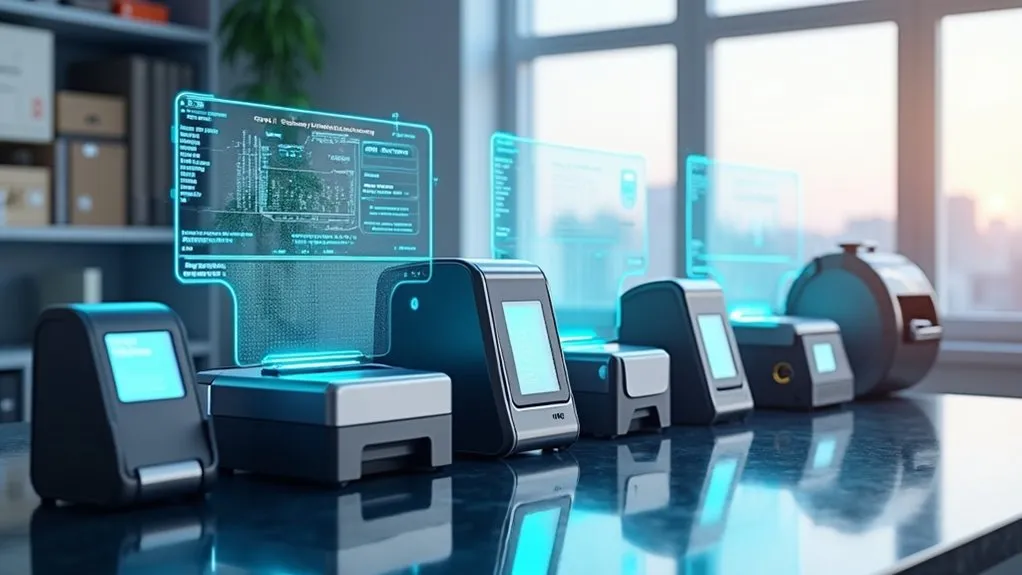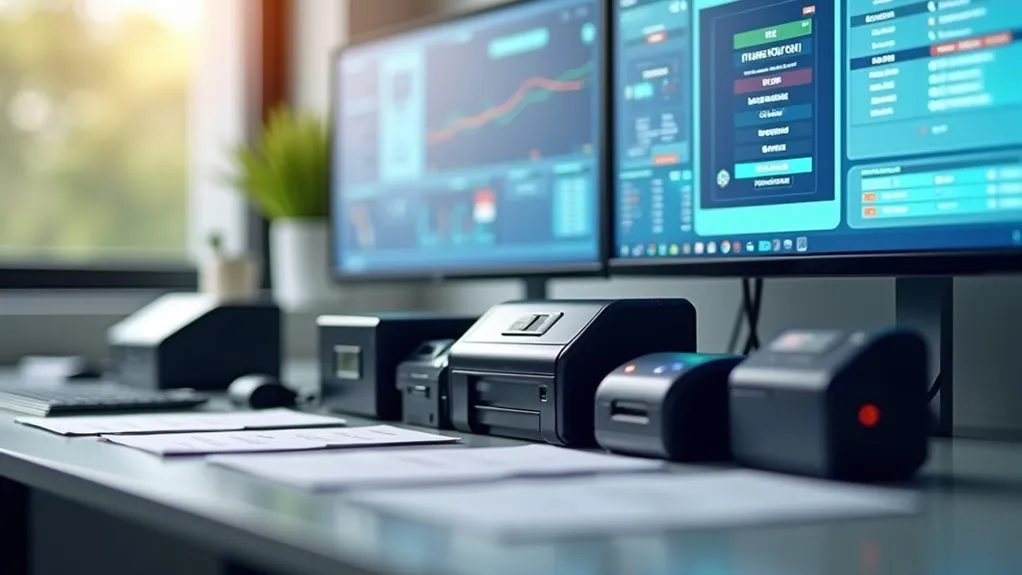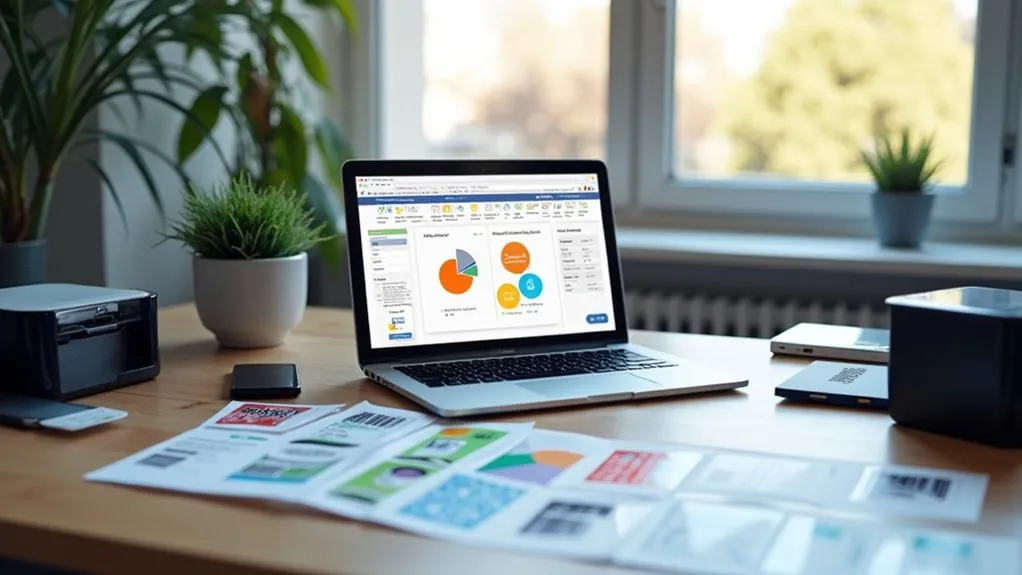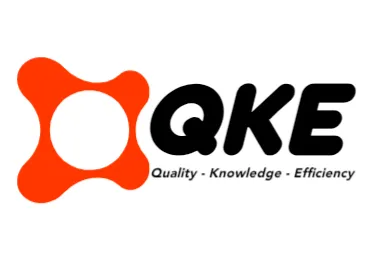For businesses seeking top labeling solutions in 2025, cloud-based platforms ensure seamless global collaboration and real-time updates. Smart labels with RFID and NFC boost inventory tracking and customer engagement. AI-driven automation slashes design and approval times, while sustainable materials like bioplastics reduce environmental impact. Compliance systems, digital printing, and personalized packaging enhance precision and branding. Integrated, scalable software streamlines operations. Explore further to uncover how these innovations can transform your business strategy.
Key Takeaways
- Explore advanced automation for real-time label updates and seamless cloud migration in 2025.
- Adopt sustainable materials like bioplastics and recycled content for eco-friendly labeling solutions.
- Ensure compliance with automated checks and anti-counterfeit measures like QR codes and blockchain.
- Enhance branding with personalized designs and interactive elements like NFC tags and AR features.
- Integrate scalable systems with ERP for error-free, cost-effective labeling operations.
Cloud-Based Labeling Platforms

In today’s fast-paced business environment, cloud-based labeling platforms have emerged as a transformative solution for organizations seeking to streamline their labeling processes. These platforms facilitate seamless cloud migration, enabling businesses to transition from outdated on-premise systems to centralized, accessible solutions. With a single source of truth, teams across global operations can collaborate efficiently, ensuring consistency and eliminating version control issues.
A standout benefit is the provision of real-time updates, allowing instant label changes and deployments to meet market demands or regulatory shifts. This agility, coupled with scalability, empowers companies to expand operations without the burden of extensive IT infrastructure. Cost efficiency through subscription-based models further enhances their appeal. Automatic updates provided by cloud providers ensure that businesses always have the latest software without downtime or manual intervention (automatic updates provided). By integrating with ERP and other systems, these platforms improve accuracy and workflow automation. Ultimately, cloud-based labeling platforms offer a strategic edge, delivering enhanced efficiency and global accessibility for forward-thinking businesses in 2025.
Smart Label Technologies

Businesses leveraging cloud-based labeling platforms gain a powerful foundation for operational efficiency, yet the integration of smart label technologies marks a significant leap forward in innovation. Smart labels, powered by RFID Innovations, enable real-time inventory tracking and supply chain visibility, transforming industries like retail and healthcare. Meanwhile, Sensor Monitoring through smart labels ensures product integrity by tracking conditions like temperature or humidity, vital for pharmaceuticals and perishables.
These technologies offer strategic advantages, enhancing both operational precision and customer engagement. Consider the diverse applications below:
| Technology | Key Benefit |
|---|---|
| RFID Innovations | Real-time asset tracking |
| Sensor Monitoring | Ensures product quality in transit |
| NFC Labels | Boosts customer interaction |
AI-Driven Automation Tools

How can labeling processes evolve beyond manual constraints to achieve unparalleled efficiency? AI-Driven Automation Tools are revolutionizing the industry by streamlining workflows and enhancing precision. These tools automate design generation, data management, and quality control, leveraging advanced algorithms to reduce manual effort by up to 70%. With capabilities like Data Augmentation, AI enriches datasets for better accuracy, while Model Fine Tuning ensures tailored solutions for specific business needs.
To highlight their impact, consider these game-changing benefits:
- Speedy Design: AI crafts multiple label variations in seconds, saving hours.
- Smart Data Handling: Programmatic labeling accelerates processes 10-100x over manual methods.
- Flawless Quality: Computer Vision detects defects, ensuring compliance.
- Efficient Approvals: Automated checks slash approval times from weeks to seconds.
Sustainable Labeling Materials

Sustainable labeling materials are emerging as a pivotal strategy for businesses aiming to align with environmental goals while maintaining operational excellence. As Eco Materials Trends gain traction, companies are turning to innovative solutions like recycled content from post-consumer waste, plant-based bioplastics such as PLA, and bio-based films from wood pulp. These materials significantly reduce carbon footprints and waste, enhancing brand appeal among eco-conscious consumers.
Exploring Biodegradable Options, businesses can adopt labels made from agricultural byproducts like sugarcane fiber or hemp, alongside wash-off adhesives that improve recyclability. The market for sustainable labels is expanding rapidly, driven by consumer demand and a focus on circular economy principles. With costs becoming competitive due to innovation, selecting materials that match application needs and end-of-life disposal options is critical. Embracing these solutions not only boosts brand reputation but also positions companies as leaders in sustainability for 2025 and beyond.
Compliance Management Systems

Navigating the complex landscape of regulatory demands is a pressing challenge for organizations aiming to maintain market relevance. Compliance Management Systems (CMS) for labeling offer a strategic solution by centralizing processes and ensuring adherence to evolving standards. These systems automate label creation, integrate data from regulatory databases, and keep pace with Regulatory Updates, such as the EU’s updated CLP Regulation or the FDA’s revised food labeling rules for 2025.
To highlight their value, consider these CMS advantages:
- Streamlined Updates: Automatically adjust labels to meet new regional requirements.
- Error Reduction: Minimize costly mistakes with precise, automated checks.
- Traceability: Maintain detailed Audit Trails for compliance verification during inspections.
- Faster Approvals: Accelerate workflows with integrated review processes.
Anti-Counterfeiting Security Features

Businesses seeking robust anti-counterfeiting measures can rely on tamper-proof seal technology, which visibly indicates any unauthorized access through designs that break or leave clear evidence of interference. Holographic authentication methods further enhance security by incorporating optically variable features that shift in appearance, making replication by counterfeiters exceedingly challenging. These innovative approaches offer a strategic shield against fraud, safeguarding brand integrity and consumer trust.
Tamper-Proof Seal Technology
In the realm of product security, tamper-proof seal technology stands as a critical defense against counterfeiting and unauthorized access. This innovative approach ensures Seal Integrity through sophisticated Barrier Designs, deterring tampering and protecting brand reputation. It integrates visual indicators, destructible labels, and residue-transfer mechanisms to reveal any interference, fostering consumer trust across pharmaceuticals, food, and luxury goods.
Key features that make this technology impactful include:
- Visible Evidence: Shrink wraps and tearable seals instantly show tampering.
- Physical Deterrence: Cap seals and tamper rings break irreversibly.
- Smart Integration: QR codes and NFC tags enable digital verification.
- Custom Protection: Unique void patterns tailored to brands.
With a market projected at $3.8 billion by 2032, tamper-proof seals are indispensable for safety and authenticity.
Holographic Authentication Methods
Cutting-edge holographic authentication methods stand as a formidable barrier against counterfeiting, leveraging the science of light diffraction to create dynamic visual effects. These Optical Security solutions employ Diffraction Techniques to produce intricate 3D images and color-shifting patterns on 2D surfaces, making replication nearly impossible without advanced technology. Features like flip-flop images, microtext, and concealed latent visuals enhance protection for currency, passports, and high-value goods.
Businesses benefit from enhanced brand protection and consumer trust, as holograms provide instant visual authentication. With the security hologram market projected to grow steadily by 2025, integrating digital tools like QR codes and blockchain further strengthens traceability. Adopting holographic methods ensures robust defense against forgery, safeguarding both reputation and revenue in an evolving threat landscape.
Digital Printing Innovations

Digital printing innovations are transforming the labeling industry with advanced printing technologies like inkjet and electrophotography, which deliver high-quality results and adaptability for diverse business needs. These cutting-edge systems enable custom label designs through Variable Data Printing, allowing businesses to personalize labels with unique details at scale. Such advancements offer strategic advantages, ensuring flexibility and efficiency in meeting modern market demands.
Advanced Printing Technology
Modern businesses seeking innovative labeling solutions are turning to advanced digital printing technologies to meet evolving market demands. These cutting-edge methods, such as inkjet and electrophotography, offer unmatched speed, quality, and flexibility through Toner Innovations and Substrate Versatility, ensuring vibrant, durable labels on diverse materials.
Explore the strategic advantages of digital printing with these highlights:
- High-Speed Output: Presses like HP Indigo V12 achieve up to 120 m/min, rivaling traditional methods.
- Precision Resolution: Resolutions up to 1200 dpi deliver crisp, professional results.
- Color Accuracy: Advanced systems match brand-specific Pantone shades effortlessly.
- Material Range: Print on paper, films, and textured surfaces with ease.
Such innovations empower businesses to optimize labeling with efficiency and impact for 2025’s competitive market.
Custom Label Design
Innovative businesses are harnessing the power of digital printing to revolutionize custom label design, unlocking new levels of creativity and functionality. This technology empowers companies to explore diverse Aesthetic Choices, from minimalist elegance to bold, vibrant visuals, while enabling seamless Pattern Integration for unique branding. Digital printing offers variable data customization, high-resolution outputs, and cost-effective short runs, making it ideal for personalized and interactive labels with QR codes or NFC tags.
| Feature | Benefit | Application |
|---|---|---|
| Variable Data | Unique content per label | Personalized offers |
| Design Flexibility | Easy artwork updates | Multi-SKU versioning |
| Enhanced Aesthetics | Vibrant, detailed visuals | Premium branding |
| Smart Integration | QR codes, NFC tags | Consumer engagement |
This strategic tool transforms labels into powerful marketing assets for 2025.
Personalized Packaging Options

The realm of personalized packaging options offers businesses a powerful tool to stand out in a competitive market. With a global market size projected at USD 38.15-40.54 billion in 2025, growing at a CAGR of 5.3-5.7%, the demand for unique packaging is undeniable. It enhances brand recognition, builds emotional connections, and drives loyalty, with 72% of American consumers influenced by packaging design.
To leverage this trend strategically, consider these engaging ideas:
- Custom Inserts: Tailor packaging with protective, branded inserts for a premium unboxing experience.
- Gift Messages: Add personalized notes or greetings to create a memorable touchpoint.
- Variable Data Printing: Incorporate unique names or designs for mass customization.
- Interactive Elements: Use QR codes or AR features for an immersive customer journey.
Integrated Business System Solutions

Integrated Business System Solutions offer transformative potential for companies seeking to optimize labeling processes through seamless ERP integration, ensuring data consistency and automation directly from platforms like SAP or Oracle. Scalable cloud platforms further enhance this capability, providing flexibility to adapt labeling operations to business growth without infrastructure constraints. This strategic alignment of systems and technology empowers organizations to boost efficiency and maintain a competitive edge in dynamic markets.
Seamless ERP Integration
While businesses strive for operational excellence, seamless ERP integration emerges as a pivotal strategy for optimizing labeling solutions. By aligning labeling systems with ERP platforms, companies ensure data accuracy, streamline operations, and enhance compliance. ERP Synchronization guarantees real-time updates, reducing errors, while thoughtful Integration Strategies simplify setup with connectors for systems like SAP or Oracle.
Key benefits include:
- Error-Free Labels: Automatic data pulls from ERP eliminate manual mistakes.
- Faster Operations: Automated printing speeds up order fulfillment.
- Cost Savings: Reduced labor and error-related expenses boost ROI.
- Regulatory Compliance: Accurate data supports adherence to industry standards.
This integration empowers businesses to leverage existing systems, driving efficiency and precision in labeling processes without compromising on quality or traceability.
Scalable Cloud Platforms
Savvy businesses are turning to scalable cloud platforms as a transformative solution for integrated labeling systems. These platforms offer adjustable infrastructure, supporting high-volume tasks with efficiency, and enable rapid deployment across global locations. With centralized control, companies can manage label templates, users, and print jobs from a single hub, ensuring consistency and traceability.
Moreover, scalable cloud platforms reduce IT costs through flexible subscription models, aligning expenses with usage. They integrate seamlessly with business systems, automate workflows, and provide secure, browser-based access for remote printing. By leveraging centralized control, firms enhance compliance and security while simplifying maintenance. For forward-thinking enterprises, these platforms are a strategic cornerstone for streamlined, scalable labeling solutions in an ever-evolving market.
Scalable Labeling Software

How can businesses ensure their labeling processes keep pace with growth and change? Scalable Labeling Software offers a strategic solution, leveraging Elastic Systems and Adaptive Frameworks to expand or contract with operational needs without disrupting service. It integrates seamlessly with ERP and WMS, supports diverse label types, and ensures compliance with regulations like FDA and GDPR.
Scalable Labeling Software adapts to business growth, integrating with ERP and WMS while ensuring compliance with FDA and GDPR regulations.
Why choose scalable software? Consider these relatable advantages:
- Growth-Ready: Handles increased workloads—more users or transactions—without performance dips.
- Cost-Smart: Reduces long-term expenses by minimizing frequent upgrades.
- Market-Agile: Adapts swiftly to customer demands or market shifts.
- Error-Free Efficiency: Boosts turnaround times with automation like auto-labeling.
Cloud-based options enhance scalability with real-time access and vendor-managed security, while on-premise setups offer data control. With trends like AI integration and smart labels (RFID, QR codes) on the rise by 2025, such software positions businesses to innovate, ensuring sustainable, secure, and compliant labeling operations.

 Tiếng Việt
Tiếng Việt 日本語
日本語 中文 (中国)
中文 (中国) 한국어
한국어
